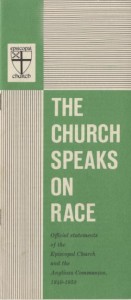 Sorting Bishop Duncan Gray Jr.’s mail into two stacks — the “good” and the “bad” — was a considerable task at the height of the civil rights movement in Mississippi.
Sorting Bishop Duncan Gray Jr.’s mail into two stacks — the “good” and the “bad” — was a considerable task at the height of the civil rights movement in Mississippi.
The small-town Episcopalian priest, known nationally for his nonviolent and pro-equality stance that segregation was incompatible with the Christian faith, received piles of letters.
A selection of Gray’s papers, including correspondence from the 1960s, are open to the public for viewing this fall in the University of Mississippi’s Archives and Special Collections. Among the hundreds of papers the bishop donated to the university — a collection that spans from the 1960s to the 1990s — are newspaper clippings, Ku Klux Klan pamphlets the bishop received in the mail and correspondence from churchmen all over the nation, pledging their support.
“My mother tried to sort them — good pile, bad pile,” said the bishop’s son, Bishop Duncan Gray III, who was an eighth-grader in September 1962, when his father plunged into a crowd of rioters, trying to calm the mob as they protested James Meredith’s integration of Ole Miss.
“The bad pile was very predictable,” Gray III said. “The good pile, I remember being touched. Dad got letters from people all over the country, but he also got letters from simple, inarticulate people, some who identified themselves as African-Americans. The simple poignancy of those, even as an eighth- and ninth-grader, I was touched by.”
As Gray Jr. lived out his calling to the ordained ministry, first in seminary and later in various churches in Mississippi, he found himself over and over again placed in locations at integral times in the civil rights era.
In the Canton native’s senior year as a seminary student at the University of the South at Sewanee, the entire seminary faculty resigned in protest over the university’s decision against admitting its first African-American student. During his time in Cleveland, Miss., the Supreme Court upheld Brown v. Board of Education, and Emmett Till was murdered just down the road. Following his tenure in Oxford in 1965, Gray moved his family to Meridian in the aftermath of the Neshoba County killings and in the midst of church and synagogue bombings. He preached for equality and nonviolence through it all.
“Bishop Gray’s legacy casts a long shadow,” said Jennifer Ford, head of the archives and special collections. “He preached acceptance, calm and nonviolence and accepting integration, and he did it in such a noble way that his legacy is hard to discount. In fact, it’s still going on.”
It was while serving at St. Peter’s Episcopal Church in Oxford that Gray became a fixture in Mississippi history. Just hours before the Sept. 30, 1962 riots broke out on the UM campus, he took to the pulpit, preaching one of his now-famous sermons admonishing violence and encouraging Meredith’s admission:
“No university in the world would defend this position rationally, and no Christian church would defend it morally,” he said to a congregation that went silent.
That evening, Gray and the university chaplain moved throughout the angry mob, removing bricks from their hands and encouraging them to go home.
Later in the night, while pleading with Gen. Edwin Walker to discourage the rioters, Gray was pulled off the Confederate statue by the mob and beaten. It did not stop him.
“Certainly I was scared,” said Gray Jr. “But more than that, I felt just total disappointment and disgust that we had gotten in that bad of shape. What was going through my mind also was to do whatever I possibly could to minimize the effect and to calm things down to whatever degree I could. I wasn’t very successful, of course, but that’s what was going through my mind.
“I was deeply concerned about the university and deeply concerned about the town of Oxford and the state of Mississippi and what was being done to all three of these.”
Among the letters is a note from Mississippi NAACP leader Aaron E. Henry, who penned a note on Oct. 8, 1962, voicing a sentiment that would have surely been sorted into the “good” pile. He wrote: “The newspaper reports of your sermon Sunday give us all hope and courage for the future.”
Henry’s letter is just one of many pieces in the Gray collection.
“I think what [viewers of this collection] will see is a pastor, a priest trying to do his job,” Gray III said. “Dad never really saw himself as a crusader, but he saw himself being placed in a particular moment at a particular time and being called by God to respond, not just to the issue but to the people.”
Gray’s papers will be housed on the third floor of the J.D. Williams Library and will be open to the public for viewing in late fall. The civil rights collection also includes the papers of James Meredith, James Silver and Russell Barrett. A portion of the collection also was displayed Sept. 30 during the university’s 50 years of integration commemorative event.
For more information about the collection or Archives and Special Collections, contact Jennifer Ford at 662-915-7639.